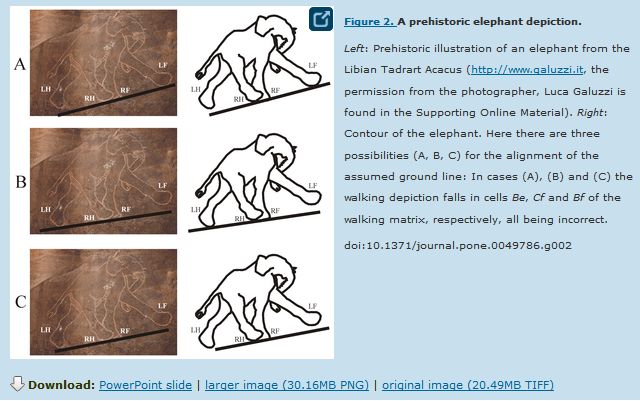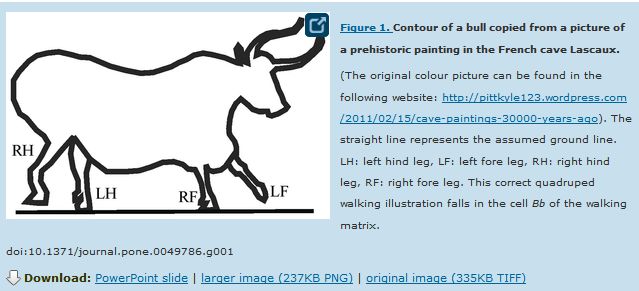It looks like you're using an Ad Blocker.
Please white-list or disable AboveTopSecret.com in your ad-blocking tool.
Thank you.
Some features of ATS will be disabled while you continue to use an ad-blocker.
12
share:
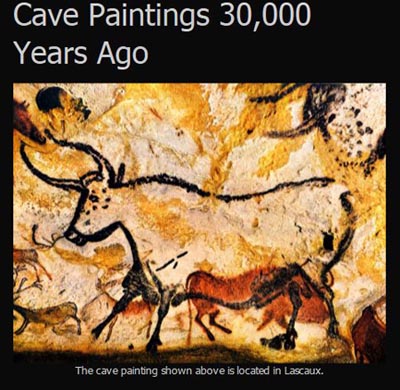
Prehistoric People Were Better Scientific Observers than Modern Ones
Until the photographer Eadward Muybridge filmed a horse running in the early 20th century, nobody was entirely certain what position horse legs were in while the animals ran. In retrospect, after scientists analyzed Muybridges films frame by frame, it turned out that many statues and paintings created of running horses before that time were incorrect. With one odd exception. A group of Hungarian scientists examined over 1,000 examples of prehistoric cave paintings and modern artistic illustrations of four legged animals running, and found that the most accurate representations by far were prehistoric.
Indeed, the error rate in prehistoric cave paintings like the elephant painting you see here is half the error rate in modern illustrations before Muybridge's time. Prehistoric artists appear to have known a lot more about animal behavior than people who lived thousands of years later.
Write the scientists in PLoS One:
- The lowest rate of error in quadruped walking illustrations analized by us, was found in cave art (46.2%) . . . The 46.2% error rate of the prehistoric quadruped walking illustrations is nearly half of the 83.5% error rate of the pre-Muybridgean illustrations. This is surprising, since it could be justly expected that the prehistoric man, with a primitive culture and artistic techniques, would work with a much greater rate of error than his later counterparts. Prehistoric men illustrated the walking of quadrupeds with almost the same error rate (46.2%) as the taxidermists of natural history museums (41.1−43.1%).
The accuracy of the prehistoric artists representations is too common for it to be mere chance. The researchers speculate that prehistoric hunters, whose entire lives might depend on observing the movements of animals, may have paid much more attention to the creatures gaits than more modern artists.
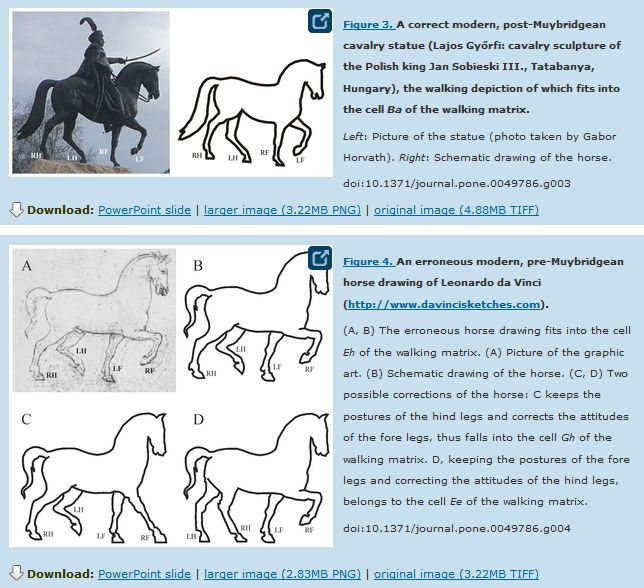
io9.com...
Source
Well this is cool. It shows you what a lot of people on ATS have been saying, people are so UN-observant of what is going on around them. But it seems it has been this way for a LONG time according to this study.. I doubt most of us could accurately draw our dogs or cats gait.
edit on 8-12-2012 by ShotGunRum because: (no reason given)
edit on 12/8/2012 by tothetenthpower because: --Mod Edit--Fixed
Link
I have a book of cave art, and there is a really interesting 'sketch' where the artist was obviously trying to capture the correct perspective on a
group of people dancing, with limited success admittedly in that case.
It was obviously very important to them to document events and record them accurately. It wasn't simply about art and creative expression.
Your OP confirms that for me, and adds to my fascination with the subject.
It was obviously very important to them to document events and record them accurately. It wasn't simply about art and creative expression.
Your OP confirms that for me, and adds to my fascination with the subject.
Modern people generally don't have to rely on observing nature for their survival.
I'm not jealous of the prehistorics though....
I'm not jealous of the prehistorics though....
This was also due to early man's ability to read the tracks of the animals. Take the elephant for instance; this is an example of a "pace" gait where
the legs on one side works in tandem with the diagonal opposite limb. There were also subtle variations of gaits such as trots, lopes, gallops, walks,
etc and each could be understood both by the footprint evidence as well as observation of the living animal. They were intimate with all the animals
and actually spent more time reading and following tracks than watching the animals themselves.
Modern bushmen in Africa even have a language of hand signs that describe details of the tracks in intimate form. This was no doubt true of any hunting culture which are fast disappearing along with their vast knowledge of the land and animals they share it with. Louis Liebenberg is an excellent source for anyone interested in learning more.
Nor was their artwork only dealing with realism, many spiritual aspects or their world were included in their paintings. Often you will see things that later European artists didn't discover until Picasso, depicting multiple views in a single image, use of "X -ray" or see through images, etc.
The debate over why they did such paintings will go on to eternity I suppose.
Do we even know why we feel the need to paint today?
Neat thread, thanks for posting this.
ETA - what's wrong with the elephant picture is they don't step on their own feet, The front foot moves slightly before the hind comes forward.
Modern bushmen in Africa even have a language of hand signs that describe details of the tracks in intimate form. This was no doubt true of any hunting culture which are fast disappearing along with their vast knowledge of the land and animals they share it with. Louis Liebenberg is an excellent source for anyone interested in learning more.
Nor was their artwork only dealing with realism, many spiritual aspects or their world were included in their paintings. Often you will see things that later European artists didn't discover until Picasso, depicting multiple views in a single image, use of "X -ray" or see through images, etc.
The debate over why they did such paintings will go on to eternity I suppose.
Do we even know why we feel the need to paint today?
Neat thread, thanks for posting this.
ETA - what's wrong with the elephant picture is they don't step on their own feet, The front foot moves slightly before the hind comes forward.
edit on 8-12-2012 by Asktheanimals because: (no reason given)
Excellent post. I would also like to point out that pre-literate humans also had a much more methodical approach to observing celestial phenomena than
most moderns, as witnessed by megalithic structures on the one hand and the countless Second Sun/The Moon Is Rising In the Wrong Place/The Stars Are
Messed Up threads here on ATS!
reply to post by ShotGunRum
Cool OP
People from 'back when' were unlikely to have been 'better' observers than people from other times. It's more likely that every generation includes a similar ratio of good/bad/crap observers. It wouldn't surprise me at all if the same creative bell curve applied to them as as much as us now.
When we see amazing art like this and this (Chauvet Caves) we're looking at the surviving works of one or more artists. Looking at the breathtaking stuff in the Chauvet galleries is like viewing Renaissance art in Italian churches...no scribblers allowed!
The skill in some paintings is on the outer edge of great talent - equal to Da Vinci and Durer. On the other hand, if we look at as much rock art as we can, some of it's great and some of it ain't!!
People from 'back when' were unlikely to have been 'better' observers than people from other times. It's more likely that every generation includes a similar ratio of good/bad/crap observers. It wouldn't surprise me at all if the same creative bell curve applied to them as as much as us now.
When we see amazing art like this and this (Chauvet Caves) we're looking at the surviving works of one or more artists. Looking at the breathtaking stuff in the Chauvet galleries is like viewing Renaissance art in Italian churches...no scribblers allowed!
The skill in some paintings is on the outer edge of great talent - equal to Da Vinci and Durer. On the other hand, if we look at as much rock art as we can, some of it's great and some of it ain't!!
reply to post by PatrickGarrow17
In the past, especially, artists relied on observing nature and everything else around them. This was their career and how they survived monetarily...and they still couldn't get it right. Even a horses gait, an animal that was around them constantly.
Modern people generally don't have to rely on observing nature for their survival.
In the past, especially, artists relied on observing nature and everything else around them. This was their career and how they survived monetarily...and they still couldn't get it right. Even a horses gait, an animal that was around them constantly.
reply to post by ShotGunRum
True, good point. I guess I sort of skipped all the time between the Paleolithic age and 2012.
I wonder what the real difference is between the mentality of a person in 28,000 BC and the people after the rise of city-states....maybe it is due to the more human-centered existence. DaVinci was phenomenal in his ability to paint the human body, as were many of the sculptors who showed an advanced understanding of anatomy.
At some point, maybe people were prioritized mentally above the entire picture of nature. I could easily believe that a Paleolithic person had a more accurate mental picture of nature at large.
I think whatever the difference was, it was probably more environmental than genetic...I think the genetics are pretty indistinguishable.
Who knows, that cave painting may have been done by the greatest genius of his time, it may not be any indication at all about the observational skills of one time vs. another.
True, good point. I guess I sort of skipped all the time between the Paleolithic age and 2012.
I wonder what the real difference is between the mentality of a person in 28,000 BC and the people after the rise of city-states....maybe it is due to the more human-centered existence. DaVinci was phenomenal in his ability to paint the human body, as were many of the sculptors who showed an advanced understanding of anatomy.
At some point, maybe people were prioritized mentally above the entire picture of nature. I could easily believe that a Paleolithic person had a more accurate mental picture of nature at large.
I think whatever the difference was, it was probably more environmental than genetic...I think the genetics are pretty indistinguishable.
Who knows, that cave painting may have been done by the greatest genius of his time, it may not be any indication at all about the observational skills of one time vs. another.
reply to post by Kandinsky
The Chauvet Cave art is amazing. As an artist myself, whoever made those had to practice for years to draw like that. Which makes me wonder if they had certain peoples whose job it was to just learn how to draw.
When we see amazing art like this and this (Chauvet Caves) we're looking at the surviving works of one or more artists. Looking at the breathtaking stuff in the Chauvet galleries is like viewing Renaissance art in Italian churches...no scribblers allowed!
The Chauvet Cave art is amazing. As an artist myself, whoever made those had to practice for years to draw like that. Which makes me wonder if they had certain peoples whose job it was to just learn how to draw.
One difference between now and back then is the way we have incorporated language and words. I would suppose whatever language they had (if any) was
composed of a few basic words without all the tangential references that come with words today. We tend to think in more abstract ways than they did
back then and infer associations that had no practical use for them. In sum their brains worked differently than ours do.
I wouldn't say ancient people were better observers. Some women can see the groceries on the shelves of stores very well. Others can spot a movie
star walking down the street just fine. Every guy can see a womans figure pretty darn clearly nowadays. People can smell Mcdonalds while driving
down the highway. A Cinnamon roll gives off an aroma that travels 500 ft. and people can hear someone popping a tab on a soda or beer rooms away.
It is our focus that has changed, we focus on electronics a lot now and learn worthless stuff while the important stuff is neglected. If you were to go to the outback of Russia or into Canada or the mountain areas of the USA you will find people who don't have compromised perception. They may appear a little backwards and unintelligent but most of the time they just know different things, like survival. We have falsely assumed what we think of as intelligence is real. Intelligence is not a specific knowledge. Intelligence is the ability to look at the whole picture along with an ability to figure out how things work. We have just been steered to a different place by the economy. Some skills are needed from this old style and should be passed on to our young. Don't put all your faith in this society, it will destroy you.
It is our focus that has changed, we focus on electronics a lot now and learn worthless stuff while the important stuff is neglected. If you were to go to the outback of Russia or into Canada or the mountain areas of the USA you will find people who don't have compromised perception. They may appear a little backwards and unintelligent but most of the time they just know different things, like survival. We have falsely assumed what we think of as intelligence is real. Intelligence is not a specific knowledge. Intelligence is the ability to look at the whole picture along with an ability to figure out how things work. We have just been steered to a different place by the economy. Some skills are needed from this old style and should be passed on to our young. Don't put all your faith in this society, it will destroy you.
reply to post by ShotGunRum
I'm a middling talent with gouache and pencils and enjoy art a lot. Like yourself, I can see the skill of the artist and the incredible
minimalism of strokes to capture the essence of movement and character. If we tried our hand with maybe pastels and paper to capture similar
qualities, I wonder how long it would take to come close? I used to do pastels of greyhounds using similar colours to Franz Marc and always found it a
challenge to really *get* the sense of motion right. More fails than prevails...
Lascaux and Chauvet probably represent some of the foremost artists alive at that time.
Lascaux and Chauvet probably represent some of the foremost artists alive at that time.
Originally posted by Kandinsky
Lascaux and Chauvet probably represent some of the foremost artists alive at that time.
It is perhaps the case that certain caves were reserved for certain artists, or that those caves had particular significance to certain occupational groups, like, as Asktheanimals points out, trackers and hunters. Certainly those paintings that are highlighted in the OP are of the highest standard and possibly represent the pinnacle of that form of expression, or the community record. They are also perhaps the ones selected editorial because they are the best preserved. There are ample examples of less refined paintings, and particularly at Altamira, of attempts to capture the life cycle of the animals that they hunted and co-existed with.
www.macroevolution.net...
whc.unesco.org...
www.bbc.co.uk...
Style and standard varies dramatically at Altamira. As well as there being many abstract and simplistic imagery, doodles and daubs, hand outlines, etc. It was obviously something that all were a part of, and just that some were better than others at it. What is also of interest at Altamira, and I am sure it exists at other sites, is using the formations of the rock as a starting block for the art, a protusion becomes a bisons face etc. It indicates to me, that they had very active imaginations, as well as great memories for recording detail which allowed them to bring the outside world of experience, inside their dwelling place. Something that we still have in common with them
reply to post by KilgoreTrout
Although I don't envy their conditions I definitely envy their uncluttered minds. Their artistic expression was coming from a cleaner awareness
of their environment and place in the world. In terms of artistic license, they had it in spades and weren't shackled to the expectations of patrons,
popular trends or worrying about their artistic merit.
No doubt there would be certain influences we're familiar with today like competition and status. Nevertheless I often like to imagine what it was like to have so few concepts and terms to express them. Our modern English dictionaries can contain over 180 000 words and how many did they have?
True. Pinnacle artists are always outnumbered by the triers and messers. The galleries of Chauvet appear to have been reserved for the gifted whereas the rock walls of the world were open to anyone with time and inclination. Standards vary. Perhaps there's a modern analogy with the graffiti world?
No doubt there would be certain influences we're familiar with today like competition and status. Nevertheless I often like to imagine what it was like to have so few concepts and terms to express them. Our modern English dictionaries can contain over 180 000 words and how many did they have?
There are ample examples of less refined paintings, and particularly at Altamira, of attempts to capture the life cycle of the animals that they hunted and co-existed with.
True. Pinnacle artists are always outnumbered by the triers and messers. The galleries of Chauvet appear to have been reserved for the gifted whereas the rock walls of the world were open to anyone with time and inclination. Standards vary. Perhaps there's a modern analogy with the graffiti world?
reply to post by Kandinsky
I kind of envy their conditions, modernity and the standards expected of women are far more time consuming, and somewhat futile by comparison, but, of course, there are the benefits to be gained from longevity etc. So mustn't grumble
What is interesting, to me, is how the Ice Age artistic expression, of the less accomplished artists, changes so dramatically when we come to the Neolithic period. It becomes far more geometric, though not in an organised sense, random shapes, lines and scratches using stone implements, much less use of paint and colour. I wonder if this was due to 'advancement' of portable art, or less communal living. Or just a lack of leisure time in order to allow the mind to wander freely, enabling those with ideas and pictures to express, to sufficiently get in the zone. I personally feel that the segregation effected by specialisation makes us far less spiritually involved in the freedom that art often aims to express.
I kind of envy their conditions, modernity and the standards expected of women are far more time consuming, and somewhat futile by comparison, but, of course, there are the benefits to be gained from longevity etc. So mustn't grumble
What is interesting, to me, is how the Ice Age artistic expression, of the less accomplished artists, changes so dramatically when we come to the Neolithic period. It becomes far more geometric, though not in an organised sense, random shapes, lines and scratches using stone implements, much less use of paint and colour. I wonder if this was due to 'advancement' of portable art, or less communal living. Or just a lack of leisure time in order to allow the mind to wander freely, enabling those with ideas and pictures to express, to sufficiently get in the zone. I personally feel that the segregation effected by specialisation makes us far less spiritually involved in the freedom that art often aims to express.
reply to post by Kandinsky
I almost forgot about this thread.
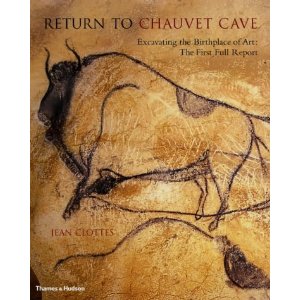
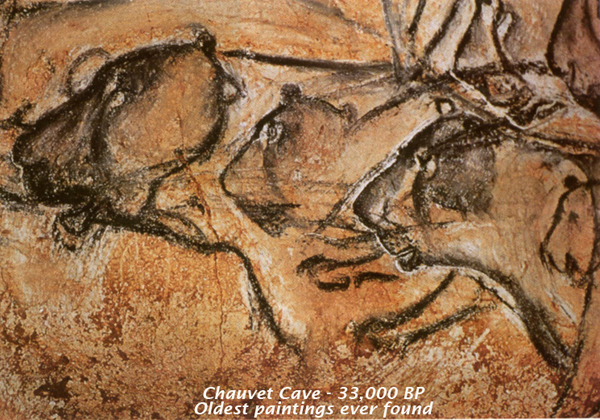
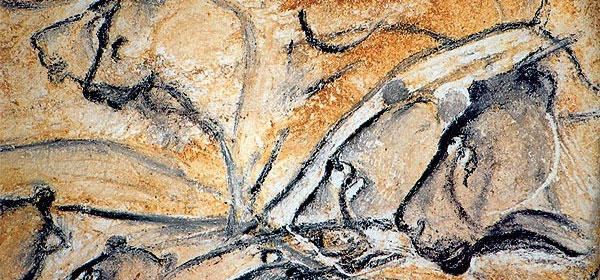
It does have a very pastel look to it. But I think it may be that way due to the grainy rock surface. Creating a stylized yet accurate version of an object is a lot harder than it looks. Especially since these people didn't have photos to reference..they had to go all by memory. I'm thinking that actually might have helped them learn faster by not having a crutch of a photo to rely on.
I almost forgot about this thread.



It does have a very pastel look to it. But I think it may be that way due to the grainy rock surface. Creating a stylized yet accurate version of an object is a lot harder than it looks. Especially since these people didn't have photos to reference..they had to go all by memory. I'm thinking that actually might have helped them learn faster by not having a crutch of a photo to rely on.
edit on 11-12-2012 by ShotGunRum because: (no reason given)
reply to post by ShotGunRum
Some of the images remind me of Franz Marc's work. For example, the palette
in this one (horses) and some of
the form in this one.
reply to post by KilgoreTrout
It's difficult for me to see distinct sea-changes in style across these epochs. I mean there are differences without being certain they were representative of a period across many regions. For instance, I wonder how influential the Chauvet artists were and how far others would travel for the experience? Just thinking aloud.
Something that I do find fascinating is the cross-section we have into at least *some* of the human consciousness of the time. I remember a moment when I was ~5 in infant school. The class was making paintings and I was in the process of slapping that narrow band of blue paint across the top of my picture as the sky; it's what kids do right? Well, I can recall the realisation that the sky actually goes all the way down and how much fricken effort it would take to cover so much page with blue paint!
Right there was a 'consciousness shift' as external reality met internal reality and childhood slipped a moment further away. I see that moment as perhaps being similar to the cultural shifts we see in art from 2-dimensional depictions and on through the Neolithic attempts to express a 3-dimensional reality. Rather than that little kid sulking that he had to paint the whole sky, he could have told the other 30 kids and they all would have had a mini-consciousness change. In that way, I ask myself if the path from Upper Palaeolithic art through to abstract Impressionism and Expressionism weren't the tiny steps of shifting human consciousness?
/end of blathering
reply to post by KilgoreTrout
What is interesting, to me, is how the Ice Age artistic expression, of the less accomplished artists, changes so dramatically when we come to the Neolithic period. It becomes far more geometric, though not in an organised sense, random shapes, lines and scratches using stone implements, much less use of paint and colour. I wonder if this was due to 'advancement' of portable art, or less communal living.
It's difficult for me to see distinct sea-changes in style across these epochs. I mean there are differences without being certain they were representative of a period across many regions. For instance, I wonder how influential the Chauvet artists were and how far others would travel for the experience? Just thinking aloud.
Something that I do find fascinating is the cross-section we have into at least *some* of the human consciousness of the time. I remember a moment when I was ~5 in infant school. The class was making paintings and I was in the process of slapping that narrow band of blue paint across the top of my picture as the sky; it's what kids do right? Well, I can recall the realisation that the sky actually goes all the way down and how much fricken effort it would take to cover so much page with blue paint!
Right there was a 'consciousness shift' as external reality met internal reality and childhood slipped a moment further away. I see that moment as perhaps being similar to the cultural shifts we see in art from 2-dimensional depictions and on through the Neolithic attempts to express a 3-dimensional reality. Rather than that little kid sulking that he had to paint the whole sky, he could have told the other 30 kids and they all would have had a mini-consciousness change. In that way, I ask myself if the path from Upper Palaeolithic art through to abstract Impressionism and Expressionism weren't the tiny steps of shifting human consciousness?
/end of blathering
Originally posted by ShotGunRum
It does have a very pastel look to it. But I think it may be that way due to the grainy rock surface. Creating a stylized yet accurate version of an object is a lot harder than it looks. Especially since these people didn't have photos to reference..they had to go all by memory. I'm thinking that actually might have helped them learn faster by not having a crutch of a photo to rely on.
It is also the nature of the rock and the degradation process. I work in a church, constructed almost entirely of Limestone between the 12th and 16th centuries, and the stone needs to breathe, few people appreciate that stone is a living thing, that very, very slowly transmutates. Somewhere down the line, someone decided it was a good idea to paint some of the steps and although all around that painted area the stone can breathe, where it is painted wants to breathe too, and so it powders the paint, slowly reducing it to a very fine dust as the lime is passed through from the underlying stone.
Many of the caves, where there is the most extensive collections of extant cave art, were, prior to discovery sealed by rock falls etc, creating a controlled environment which stabilised the internal environment. As soon as that seal was broken, the degradation started, and particularly, the realise of lime from the stone. The breath of visitors in particular can be quite corrosive to the paint that the artists used to. So, in short, I imagine that when they were first painted, that the colour was quite solid and vibrant, and that over time, it is has achieved that powdery, pastel like quality.
Originally posted by Kandinsky
Right there was a 'consciousness shift' as external reality met internal reality and childhood slipped a moment further away. I see that moment as perhaps being similar to the cultural shifts we see in art from 2-dimensional depictions and on through the Neolithic attempts to express a 3-dimensional reality. Rather than that little kid sulking that he had to paint the whole sky, he could have told the other 30 kids and they all would have had a mini-consciousness change. In that way, I ask myself if the path from Upper Palaeolithic art through to abstract Impressionism and Expressionism weren't the tiny steps of shifting human consciousness?
/end of blathering
I enjoyed the blather...I am going to take time to think about it though...leaf through a couple of books and get back to you...I feel as though you may have touched upon something, and I would like to give it full consideration.
new topics
-
Scary video of face in an abandoned house
Paranormal Studies: 56 minutes ago -
Just Came Across These Unusual Old UFO Pics
Aliens and UFOs: 3 hours ago -
LA Mayor Bass Demanded $49M in Additional LAFD Cuts One Week Before Wildfires
Mainstream News: 4 hours ago -
Sepultura - Territory - With New Drummer Greyson Nekrutman
Music: 5 hours ago -
Carry On!
Short Stories: 6 hours ago -
This should be plastered all over the airwaves
Mainstream News: 11 hours ago
top topics
-
This should be plastered all over the airwaves
Mainstream News: 11 hours ago, 23 flags -
LA Mayor Bass Demanded $49M in Additional LAFD Cuts One Week Before Wildfires
Mainstream News: 4 hours ago, 17 flags -
Archbisop Vigano Warns of Deep State and Deep Church
New World Order: 14 hours ago, 16 flags -
Oh, Good Gosh. “Kremlin Warns Stay Away from Greenland.”
World War Three: 13 hours ago, 11 flags -
Just Came Across These Unusual Old UFO Pics
Aliens and UFOs: 3 hours ago, 4 flags -
Carry On!
Short Stories: 6 hours ago, 3 flags -
Sepultura - Territory - With New Drummer Greyson Nekrutman
Music: 5 hours ago, 2 flags -
Scary video of face in an abandoned house
Paranormal Studies: 56 minutes ago, 2 flags
active topics
-
Los Angeles brush fires latest: 2 blazes threaten structures, prompt evacuations
Mainstream News • 363 • : marg6043 -
Statements of Intent from Incoming Trump Administration Members - 2025 to 2029.
2024 Elections • 64 • : WeMustCare -
This should be plastered all over the airwaves
Mainstream News • 54 • : fringeofthefringe -
Archbisop Vigano Warns of Deep State and Deep Church
New World Order • 9 • : CosmicFocus -
Post A Funny (T&C Friendly) Pic Part IV: The LOL awakens!
General Chit Chat • 8015 • : baddmove -
Carry On!
Short Stories • 2 • : JJproductions -
Scary video of face in an abandoned house
Paranormal Studies • 0 • : ColeYounger2 -
Trump says ownership of Greenland 'is an absolute necessity'
Other Current Events • 160 • : BedevereTheWise -
Oh, Good Gosh. “Kremlin Warns Stay Away from Greenland.”
World War Three • 30 • : ARM19688 -
A Flash of Beauty: Bigfoot Revealed ( documentary )
Cryptozoology • 8 • : BeyondKnowledge3
12

